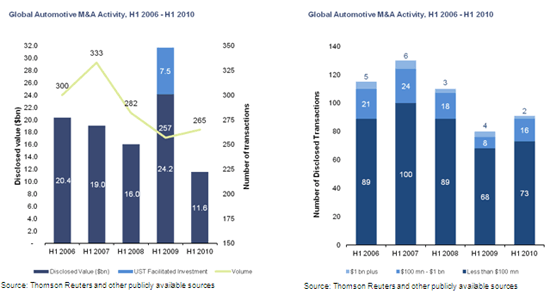The global automotive industry merger and acquisition (M&A) deal market shows a cautious uptick in deal volumes observed during the first half (H1) of 2010, against a backdrop of the lowest disclosed deal value in five years, according to the automotive transaction services practice at PricewaterhouseCoopers LLP In H1 2010, 265 deals closed with a disclosed value of $11.6 billion.
"It is evident that economic conditions constrained the deal market, forcing buyers to be focused on synergistic transactions during the first half of 2010," said Paul McCarthy, US automotive transaction services strategy leader, PricewaterhouseCoopers LLP. "In the near-term, the bulk of the automotive M&A market will likely be smaller, targeted deal activity."

For much of 2009, the deal market remained a setting for companies’ restructurings, divestitures, and capital infusions, notes McCarthy. However, as firms aim to position themselves for long-term success, the deal market appears to be transitioning towards creating and executing strategies for sustainable growth and value creation. Focus on synergistic transactions during H1 2010, coupled with the subdued pace of economic recovery meant smaller but arguably more strategic transactions.
In contrast, H1 2009 was characterized by unusually high disclosed deal value due to government-driven bailouts and the completion of two megadeals conceived in 2008. Government investment and the two megadeals made up $21.8 billion of the $31.6 billion in disclosed deal value in H1 2009. With most of the massive restructuring behind us and given a cautious credit environment, H1 2010 precluded such megadeals, resulting in a 63 percent year-over-year decline in overall disclosed deal value.
Compared to H1 2009, vehicle manufacturers and component suppliers were more active in the deal market. Much of the activity was carried out by companies seeking to: (i) divest non-core businesses (ii) bolster core competencies and (iii) engage new markets or customers. On the other hand, deal volumes for the 'Other' category, which includes retail, aftermarket, rental/leasing and wholesale, etc., have seen a significant decline.
From a regional perspective, Asia accounted for the largest share of global disclosed deal value, much of which was driven by cross border acquirors. Traditionally a region with a much smaller share, Asia’s disclosed deal value was driven by a few large vehicle manufacturer transactions. Additionally, these large transactions also resulted in Asia receiving the largest deal inflow as opposed to H1 2009, when Asia experienced a net deal outflow.
While the North American automotive industry focused on its rightsizing and turnaround efforts, the European industry was very active in the deal market during H1 2010. European acquirers accounted for 50% of global M&A activity by volume and with six of the top 10 global transactions executed by European acquirers, they also accounted for 56% of the global disclosed transaction value.
The decreasing share of disclosed global deal value involving financial buyers from H1 2008 to H1 2009 has reversed in H1 2010. While financial buyer deal volumes have held steady during H1 2010, their activity appears to be rebalancing between the three target automotive sub-sectors. During H1 2009, financial buyers chose to focus their acquisitions in the aftermarket and retail sub-sectors given the uncertainty in the automotive production environment. With stabilization of production levels in H1 2010, financial buyers have once again began focusing on deals in the supplier and vehicle manufacturer sub-sectors.
Trade buyers, while slightly more active than last year, were more strategic in their acquisitions with most deals involving specific product lines, technologies, or geographies. This is likely to remain the status quo until the credit environment eases and the global market recovers in a meaningful way.
Outlook of deal activity
The auto industry and its supply base are still in the process of structural change and reinventing its business model. Strategic objectives such as growth-based strategies (increasing market share, acquiring technologies or accessing new markets) or product portfolio driven strategies will continue to shape and define much of the deal market. As a result, smaller, targeted deals are likely to remain the majority of the deal activity in the near term.
"With the worst of the economic and credit crisis behind them, financial buyers are likely to show renewed interest in the automotive deal market," explained Paul Elie, U.S. automotive transaction services leader, PricewaterhouseCoopers LLP. "Looking ahead, we anticipate larger deals coming to fruition in 2011 as the market improves and participants jockey for global leadership."




